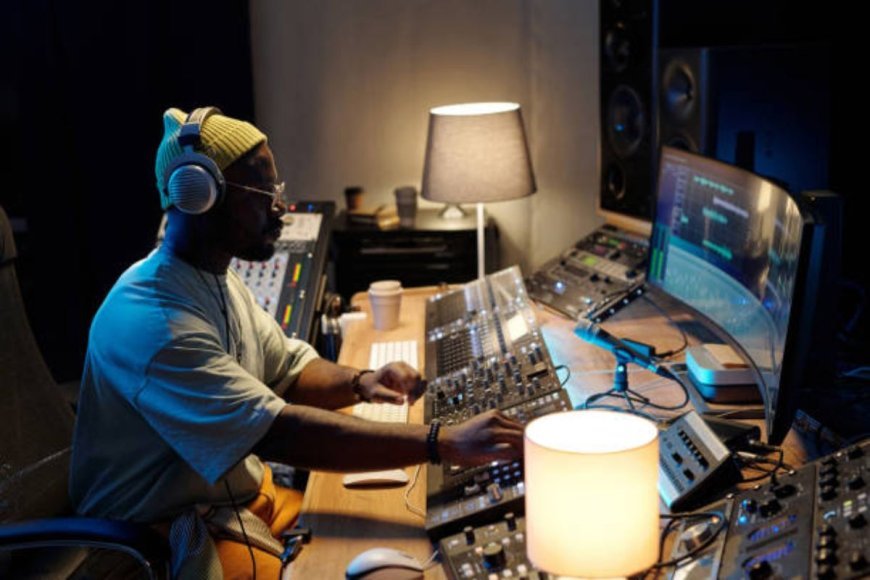Audio to Output: Explore Key Concepts in Music Production

Introduction: The Journey of Sound
Sound production is the technological and artistic process that transforms raw audio into a final soundtrack or song. Whether it's a number one hit or a score to accompany, all sounds are raw audio and end up as a finished product ready for the masses. But what happens to make it happen?
Today, the majority of potential producers are interested in music production courses in India so that they can understand this process better. These courses break down the process into simple steps that are easy to follow, and even newbies can do it. Without professional training, however, anyone can learn the basics by respecting each phase of production.
Let us take a look at the whole music creation process—from the spark of idea to the final audio output—in simple and easily understandable terms.
1. The Creative Spark: Starting off with a Musical Idea
All songs of music begin with an idea. This is maybe a tune you hear in your head, a hum that issues from your throat, or maybe a mood that you feel you must express. Musicians might simply begin with a chord progression, a vocal line, or a rhythm pattern.
Now, here at this point, equipment like digital controllers or keyboards are typically used to experiment. But remember, creativity is paramount here. This is not a question of using high-end equipment—it's a question of how you translate ideas to sound.
2. Recording: Recording the Raw Sound
Once the idea is established, recording comes next. This is when microphones, instruments, and software are used. If it's vocals or live instruments being recorded, the goal is to get the cleanest sound.
Important things in this phase:
Gain: Regulates how loud the input signal is.
Clipping: When the signal is too loud and distorts.
Room Acoustics: The form and material of the room determine how sound is picked up.
Even at this basic stage, mastering the art of recording clearly is crucial so that audio remains useable for later stages.
3. Editing: Cleaning and Organizing the Audio
Once you obtain the recordings, the next step is editing. This is where raw recordings are trimmed, adjusted, and arranged. Glitches are edited out, timing is corrected, and tracks are arranged.
Editing techniques that are often employed:
Cutting: Removing the unwanted parts.
Quantizing: Realignment of the timing of the notes to accommodate the rhythm.
Comping: Combining the best of different takes into one perfect performance.
Good editing tightens up the music and makes it sound more professional before entering the next level.
4. Sound Design: Shaping the Tone
Sound design is the act of shaping sounds using synthesizers, samplers, or effects. It is where producers experiment with different textures to give the track a distinctive character.
Some key words of sound design:
Oscillators: Generate the base waveforms in synthesizers.
Filters: Remove unwanted frequencies.
Envelopes: Govern how the sound evolves over time (attack, decay, sustain, release).
Sound design is like coloring—it creates the mood and atmosphere of your music.
5. Structure: Arranging the Song
Once the sounds are prepared, it's time to structure the song. Arrangement is all about the form—how the intro flows into the verse, the build-up to the chorus, and so on.
Typical song structure may look something like this:
Intro → Verse → Chorus → Verse → Bridge → Chorus → Outro
Transitions are also added at this point. They are risers, drum fills, and drop-outs, which ensure a good transition between one section and another.
6. Mixing: Balancing the Elements
Mixing is likely the most important aspect of music production. That is where all that has been recorded and created is brought together to balance so that there is a unified sound.
Key mixing tools:
EQ (Equalization): Used to get instruments to sit better within the mix.
Compression: Used to manage dynamics, bringing down loud areas and bringing up quiet areas.
Reverb & Delay: Used to create space and depth.
A nice balance ensures vocals are clear, drums punch through, and one instrument doesn't dominate another instrument. It's similar to cooking—each ingredient needs to be added in the right amount.
7. Mastering: The Final Shine
Mastering is the final stage before releasing the song. Mastering gives the final shine to the track and makes sure it sounds great on all playback systems—phones, cars, headphones, and speakers.
Mastering's main goals:
Loudness: Making the song at an equal and competitive level.
Consistency: Making all the tracks on one album sound identical.
Format Conversion: Converting the audio into the correct formats (MP3, WAV, etc.).
While it's an unobtrusive process, mastering is very important to make your music sound finished and professional.
8. Exporting: Audio to Output
The final step is to export your finished track in audio form. This is where the music is converted into a format that people can listen to, stream, or purchase.
Standard audio formats include:
WAV: High-quality, large-file type.
MP3: Compressed, small file size.
Share on:.
Once exported, your music is now out in the world waiting to be discovered. For those wanting to perfect this whole procedure, many opt to pursue music production courses in Bangalore to experience firsthand the actual tools and techniques used.
Conclusion: From Spark to Sound
Music production is a great blend of technique and creativity. Be it a beginner with a basic setup or a professional, knowing the key steps—from thought to final product—is what leads you and allows you to create your musical idea.
You don’t need to be an expert to get started. All it takes is curiosity, practice, and a willingness to learn. Over time, these concepts become second nature, and you’ll be producing polished, impactful tracks that resonate with your listeners.
What's Your Reaction?




















































